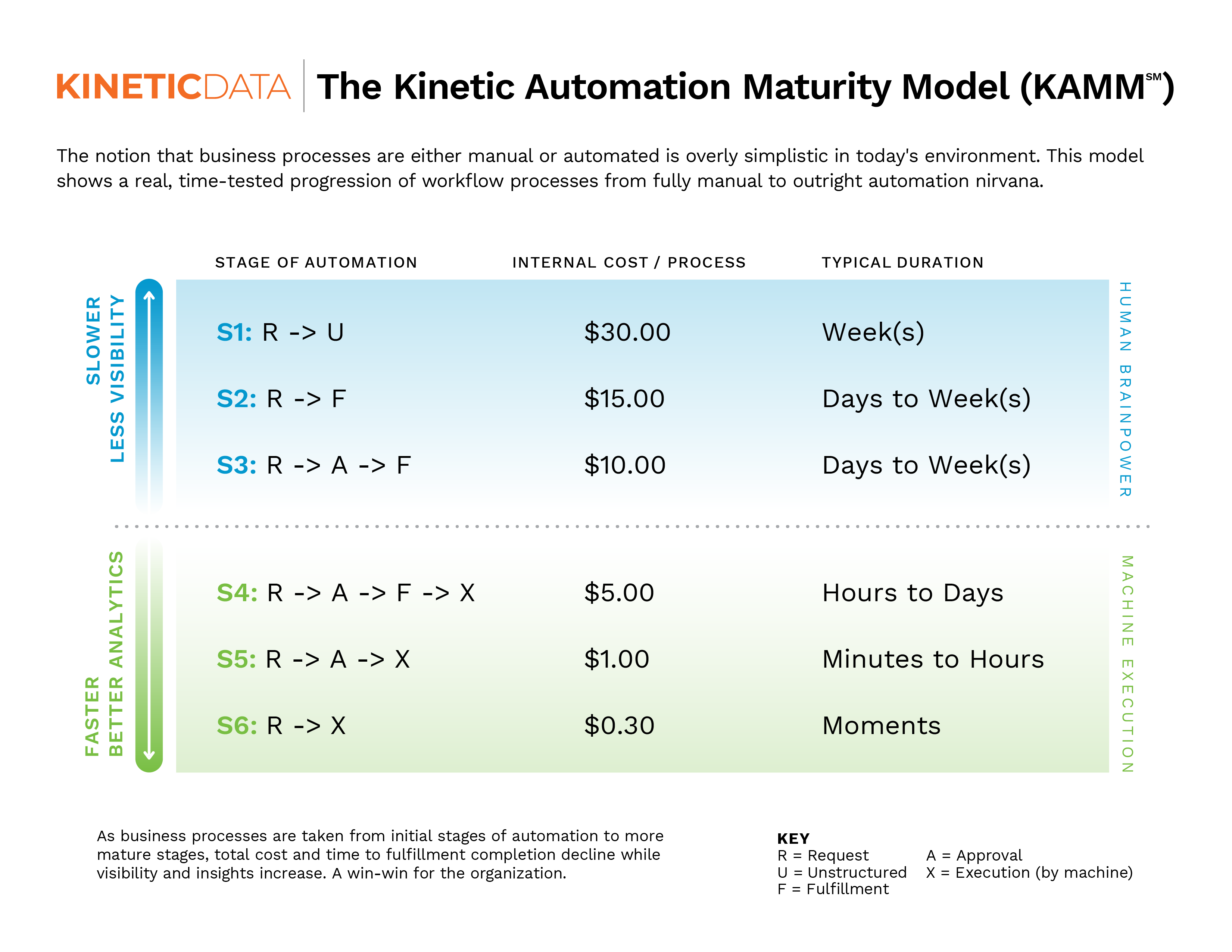Kinetic Automation Maturity Model (KAMM)
A methodology for workflow automation with a goal to identify which business processes are ripe for digital transformation improvements.
Ralph Waldo Emerson famously said, “Life is a journey, not a destination.” He could just as well have been referring to business process automation. At Kinetic Data, we’ve seen hundreds of leading government agencies and organizations struggle with the concepts of workflow automation applied to their particular environment. It’s why we created our automation maturity approach, and we call it the Kinetic Automation Maturity Model (KAMM).
Let’s break down this methodology into six stages for assessment and opportunity.

Business Process Automation Overview
All business processes start with a request (e.g., a customer places an order; an employee submits an IT support ticket; an executive asks for a report; etc.) and end with fulfillment. Redesigning workflows to replace manual, human steps with digital, machine-executed tasks provides significant relief from other high-touch, labor-intensive processes.
 Business processes targeted for improvement generate such results because of iteration. The spectrum of iteration ranges from fully manual to complete automation of workflows. All iterative workflows have the fundamental goal of improving productivity, lowering completion time and ultimately optimizing the quality to complete and free resources for meaningful work outcomes.
Business processes targeted for improvement generate such results because of iteration. The spectrum of iteration ranges from fully manual to complete automation of workflows. All iterative workflows have the fundamental goal of improving productivity, lowering completion time and ultimately optimizing the quality to complete and free resources for meaningful work outcomes.
Even partial business process flow automation improves productivity and outcomes. Let’s not forget that not every process needs full automation. It simply may be 20% automation yields the maximum efficiency. But when determined as a process candidate, full workflow automation results in much more dramatic savings as we’ll see shortly.
The Kinetic Automation Maturity Model (KAMM) details the steps in this process. Every business process within your agency or company is at one of these phases. Knowing or learning which processes are ripe for increasing automation will result in focused efforts on the highest-impact activities to move forward.
By increasing your business process automation maturity level, you can get more work done faster, with greater accuracy, compliance and agility.

S1 (R → U)
This is an unstructured, unmanaged process. It provides no visibility to the requester and is manually fulfilled. For example: a user, a customer or a partner submits a request (“R”) through a form or by sending an email. On the other end, a human decides what to do with that unstructured (“U”) request and then must determine how to handle and how to complete.
Based on research from Forrester, Gartner and other sources, the average cost of a manual process is pegged at about $30.
S2 (R → F)
When an agency or organization implements a proper system such as the Kinetic Platform and starts with the most basic step toward automation, the process becomes structured and managed.
Although fulfillment (“F”) is still manual, at this stage the request would get assigned to a specific team. It would naturally have an SLA that is enforced. If it wasn’t fulfilled within three days, they would get a reminder. If it’s still not fulfilled three days after that, the request would get escalated. The requester can check on and view the current status of the request at any time.
This prevents any requests from falling through the cracks or ending up in limbo. Adding structure, management and visibility cuts the cost approximately in half.
S3: R → A → F
At this stage, some steps in the process are automatically completed ahead of time. For example, a support ticket is created and the request is automatically routed to the correct area for approval (“A”) based on type, so fulfillment can be more effective and completed in fewer steps.
In the previous stage (S2), the individual doing the fulfillment needed to know the complete process and mentally keep track of all the steps. In this stage, the next step is taken to build and automate some steps in the process through the Kinetic Platform, taking manual steps out of fulfillment. That further reduces the cost to fulfill the request.
S4: R → A → F → X
In the previous stage, the request was approved, then fulfilled by a person “swivel-chairing” into a different system to complete a task. At this stage (S4), that individual can do everything in the Kinetic Platform and will automatically complete the action in the other system. Eliminating the swivel chair reduces the fulfillment cost to $5.
The “X” in this case is execution. It may be an API call or updating a database record, but in any case, the action is completed in the Kinetic Platform.
Note the horizontal dashed line in the infographic. Above that line, fulfillment requires a human brain process; a human is figuring out what to do. Below that line, the system has stored the definition and map of the process, so it is moving through the process steps automatically rather than relying on a human brain.
S5: R → A → X
At this stage, there’s no need for a human to do anything except possibly approve the request under certain circumstances. The process starts when a request is submitted. The system checks to see if approval is required, and if it is, a request is sent to the predefined individual for approval. Otherwise, the system just proceeds through the steps in the fulfillment process.
The system now has enough information about what is needed in the request itself. The process is well enough established for the system to reliably execute it.
S6: R → X
The final stage of full automation is request to execute. It’s common enough that no approval is needed because of iteration, learning and adjusting are focusing on this highest-value work output. Using the Kinetic Platform with the flexibility to de-risk iterations, users can optimize out steps that just don’t need to happen at all.

KAMM Steps & Cost Savings
At the first stage, industry analysts like Forrester and Gartner have pegged the average cost of an unstructured process at $29-$30. This essentially means the requester is typing into a free text field or sending an email describing what they want.
Simply structuring and managing the process — providing the user with predefined fields to fill out, drop-down values, etc. instead of free text and assuring that process steps get completed in a timely manner — cuts the fulfillment cost in half.
Removing Humans from the Equation
Taking the human out of the fulfillment process (e.g., eliminating the swivel chair) reduces the cost by another third. And then below the dashed line where humans are taken out of the loop completely, the process is optimized by eliminating unnecessary steps, the workflow is fully automated, and it provides complete status visibility, costs drop dramatically.
As the KAMM model shows, process automation isn’t simply a matter of flipping a switch. It’s an iterative workflow process. In parallel, organizations move individual processes through this process from unstructured and unmanaged to fully automated, while also repeating this exercise with more and more processes.

Summing things up
The resulting cost savings can be remarkable. In our next post, we’ll look at the components of process cost in greater detail. We’ll follow that up with a series of posts explaining each stage of process automation maturity more fully.
Try the Kinetic Platform Today.
When you're ready to learn how Kinetic Data can help you achieve better business outcomes, we're here to answer your questions.